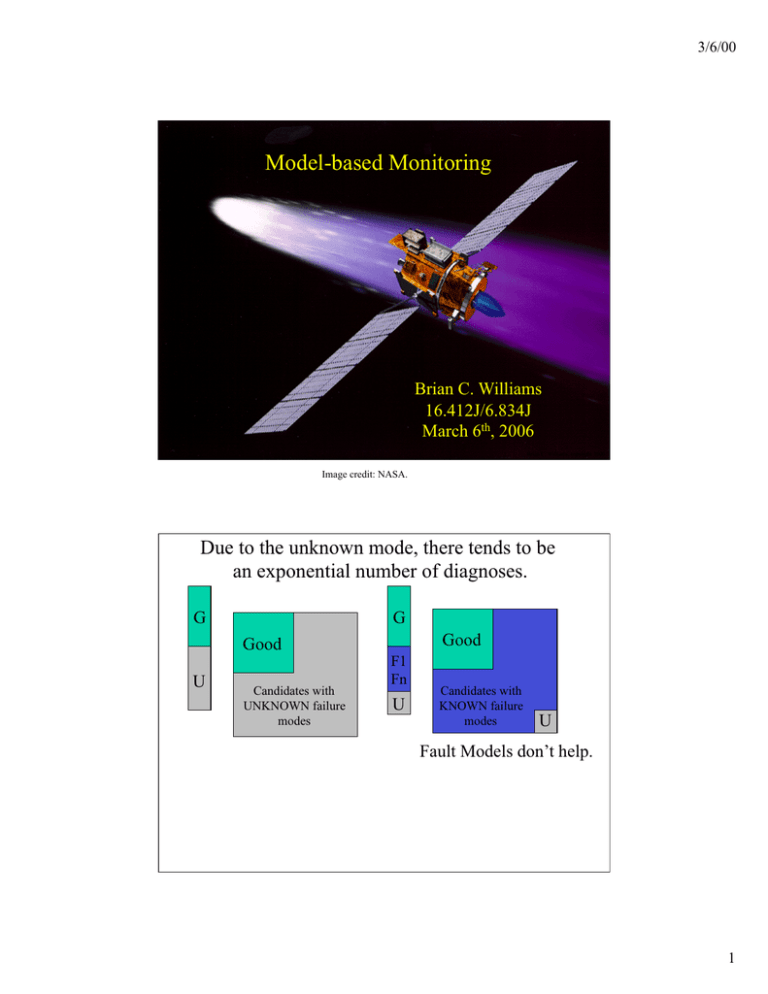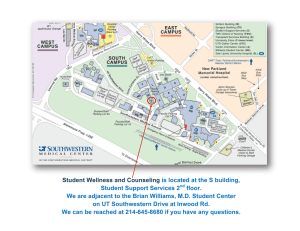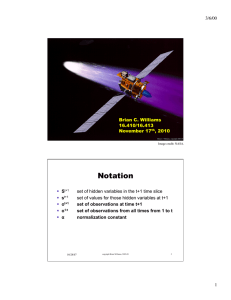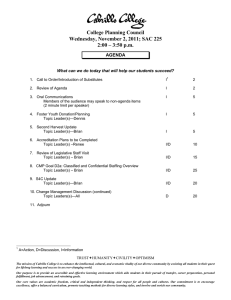Document 13356830
advertisement

3/6/00 Model-based Monitoring
Brian C. Williams
16.412J/6.834J
March 6th, 2006
Brian C. Williams, copyright 2000
Image credit: NASA.
Due to the unknown mode, there tends to be
an exponential number of diagnoses.
G
G
Good
Good
U
Candidates with
UNKNOWN failure
modes
F1
Fn
U
Candidates with
KNOWN failure
modes
U
Fault Models don’t help.
1
3/6/00
Due to the unknown mode, there tends to be
an exponential number of diagnoses.
G
G
Good
U
Candidates with
UNKNOWN failure
modes
Good
F1
Fn
U
Candidates with
KNOWN failure
modes
U
Fault Models don’t help.
But “unknown” diagnoses represent a small fraction
of the probability density space.
Most of the density space may be approximated by
enumerating the few most likely diagnoses
Sequential
Model-based Diagnosis
Input:
• Set of component mode variables M, with finite domains.
• Set of observables X, with finite domains.
• Device model Φ over M and X, in propositional logic.
• Prior distribution P(Mi) of mode assignments for each component i.
• Observation sequence X1,n = x1,n provided dynamically.
Output:
• P(M)
• P(M | X1,n = x1,n)
updated after each observation is received.
Prior Probability of Failure
Posterior Given Observation
Assume:
• Independence of component mode prior distribution.
• Conditional independence of observations given candidate (Naïve Bayes).
• Uniform distribution of observables, given candidate.
2
3/6/00
Mode Estimation Example
0
A
X
Inverter(i):
• G(i):
• S1(i):
• S0(i):
• U(i):
B
Y
C
0
Out(i) = not(In(i))
Out(i) = 1
• Isolates surprises
Out(i) = 0
• Explains
Nominal, Fault and Unknown Modes
Sherlock
[de Kleer & Williams, IJCAI 89]
Candidate (Prior) Initial Probabilities
Assume Independence
Of Initial Mode
P(G(A),G(B),G(C)) = .97
P(S1(A),G(B),G(C)) = .008
P(S1(A),G(B),S0(C)) = .00006
P(S1(A),S1(B),S0(C)) = .0000005
3
3/6/00
Posterior Probability, after
Observations X1,n = x1,n
Bayes’
Normalization
Rule Term
For n > 1:
Observations are conditionally independent
Estimating the Observation
Probability P(xi | M)
Assumption: All consistent observations for Xi are equally likely
P(xi | M) is estimated using model, Φ, according to:
• If previous observations X1,i-1 = x1,i-1, M and Φ entails Xi = xi
Then P(xi | M) = 1
• If previous observations X1,i-1 = x1,i-1, M and Φ entails Xi ≠ vi
Then P(xi | c) = 0
• Otherwise, Assume all consistent assignments to Xi are
equally likely observations:
let Dci ≡ {xc∈ DXi | c, Φ is consistent with Xi = xc }
Then P(xi | M) = 1/|Dci|
5
3/6/00
in
0
A
X
B
Y
C
out
1
Observe out = 1:
• m = <G(A),G(B),G(C)>
• Prior: P(m)
= .97
• P(out = 1 | m) = ?
• =1
• P(m | out = 0) = ?
• = 1 x .97 x α
in
0
A
X
B
Y
C
out
0
Observe out = 0:
• m = <G(A),G(B),G(C)>
• P(m)
= .97
• P(out = 0 | m) = ?
• =0
• P(m | out = 0) = ?
• = 0 x .97 x α = 0
6
3/6/00
in
0
A
X
B
Y
C
out
0
Example: Tracking Single Faults
• Which are eliminated?
• Which are predict observations?
• Which are agnostic?
Priors for Single
Fault Diagnoses:
in
0
A
X
B
Y
C
out
Leading diagnoses before output observed
7
3/6/00
in
0
A
X
B
C
Y
out
0
Top 6 of 64 = 98.6% of P
Leading diagnoses before output observed
Due to the unknown mode, there tends to be
an exponential number of diagnoses
G
G
Good
U
Candidates with
UNKNOWN failure
modes
Good
F1
Fn
U
Candidates with
KNOWN failure
modes
U
But these diagnoses represent a small fraction
of the probability density space.
Most of the density space may be represented
by enumerating the few most likely diagnoses
8
3/6/00
Optimal CSP
OCSP= <Y, g, CSP>
– Decision variables Y with domain DY
– Utility function g(Y): DY → ℜ
– CSP is over variables <X,Y>
Find Leading arg max g(Y)
Y ∈ Dy
s.t. ∃ X ∈ DX s.t. C(X,Y) is True
Encode C in propositional state logic
g() is a multi-attribute utility function that is preferentially
independent.
Outline
• Self-Repairing Agents
• Formulating Diagnosis
• Diagnosis from Conflicts
• Single Fault Diagnosis
• Extracting Conflicts
11/02/09
copyright Brian Williams, 2000-10
18
9
3/6/00
Extracting Conflicts
using Unit Propagation
1
1 A
1 B
1 C
0 D
1
X
A1
0
X1
Y
A2
X2
1 E
F 0
G
Z
A3
Symptom:
F is observed 0, but should be 1 if A1, A2 and X1 are okay.
Conflict:
{A1=G, A2=G, X1=G} is inconsistent.
→ At least A1=U, A2=U or X1=U
copyright Brian Williams, 2000-10
11/02/09
19
Find Symptom Using Unit Propagation
while Maintaining Support for Propagation
true
r
false
t
q
C1 : ¬r ∨ q ∨ p
true
false
C2: ¬ p ∨ ¬ t
p
procedure propagate(C)
Input:
C is a clause
if all literals in C are false except l, and l is unassigned
then assign true to l and
record C as a support for l and
for each clause C’ mentioning “not l”,
propagate(C’)
end propagate
copyright Brian Williams, 2000-10
11/02/09
20
10
3/6/00
Find Symptom Using Unit Propagation
while Maintaining Support for Propagation
A1=G
A=1
C=1
true
true
true
A1=G
A=1
C=1
¬(F=1) ∨ ¬(F=0)
true
¬(A1=G) ∨ ¬(A=1) ∨ ¬(C=1) ∨ X=1
X=1
X1=G
¬(X1=G) ∨ ¬(X=1) ∨ ¬(Y=0)
X1=G
true
true
F=1
F=0
∨ F=1
F=0
true
true
¬(A2=G) ∨ ¬(D=0) ∨ Y=0
true
true
A2=G
D=0
A2=G
D=0
Y=0
copyright Brian Williams, 2000-10
11/02/09
21
Extract Conflict by Tracing Support
A1=G
A=1
C=1
true
true
true
A1=G
A=1
C=1
¬(F=1) ∨ ¬(F=0)
true
¬(A1=G) ∨ ¬(A=1) ∨ ¬(C=1) ∨ X=1
X=1
X1=G
¬(X1=G) ∨ ¬(X=1) ∨ ¬(Y=0) ∨ F=1
X1=G
true
true
F=1
F=0
F=0
true
true
¬(A2=G) ∨ ¬(D=0) ∨ Y=0
true
true
A2=G
D=0
A2=G
D=0
11/02/09
Y=0
Symptom:
F observed 0 but predicted 1.
Conflict:
{A1=G, A2=G, X1=G}.
copyright Brian Williams, 2000-10
22
11
3/6/00
Extract Conflict by Tracing Support
procedure Conflict(C)
Input:
an inconsistent clause C.
Output: A conflict of C.
for each literal I in C
union Support-Conflict(l, support(l))
end Conflict
procedure Support-Conflict(l, S)
Input:
l is a literal and S is the support clause of l.
Output: A set of mode assignments supporting l.
If unit-clause?(C)
If mode-assignment?(literal(C))
Then {literal(C)}
Else {}
Else for each literal I1 in C, other than l
Union Support-Conflict(l1,
copyright support(l1))
Brian Williams, 2000-10
11/02/09
end Support-Conflict
23
procedure Test_Candidate(c, M, obs)
Input:
Output:
Candidate c, Model M, Observation Obs.
Consistent or a conflict.
Assert candidate assignment c;
Propagate obs through model M using unit propagation;
If propagate results in an inconsistent clause
Return Conflict(c);
Else
Search for satisfying solution using DPLL;
If inconsistent
Return c as a conflict;
Else
Return consistent;
End Test_Candidate
11/02/09
copyright Brian Williams, 2000-10
24
12
MIT OpenCourseWare
http://ocw.mit.edu
16.410 / 16.413 Principles of Autonomy and Decision Making
Fall 2010
For information about citing these materials or our Terms of Use, visit: http://ocw.mit.edu/terms.


